The wild countryside is perhaps not where the Fortuner and Endeavour typically do their roving. No, it’s usually a highway or even a Monday morning gridlock in a big city. But what makes them so special is that they can climb every mountain and ford every stream if you wanted them to. So, of course, we had to take them off the tarmac, then off the beaten path, then off the un-beaten path, until there was no path at all.
These are big – no, huge – SUVs with pick-up-truck-derived chassis and ferociously robust four-wheel-drive systems, yet, the toughest terrain most of their owners will subject them to is probably a poorly made speed breaker on the way to a hill station outside town. So perhaps it’s best to focus less on the locking differentials, the Terrain Management traction software and the low range gearbox, meatily exciting as those things are, and focus on what’s really important to buyers.
MUSCLE BEACH
If you want subtle, you’ve come to the wrong place. A huge part of these SUVs’ appeal is how imposing and in-your-face they are, and both cars have taken that basic trait from their predecessors and magnified it. The Toyota has gone from dull and basic to downright edgy and extravagant, in line with the brand’s mission to make its cars more ‘emotional’. The headlamps are thin, pointy slits, sitting on either side of a sharp V-shaped grille. The chin is sunken in to make the nose stick out, but it too has huge metallic surrounds for its fog lamps. There’s no shortage of drama on the sides too, where the window line kinks up sharply at the C-pillar, culminating in a wraparound rear glass. The tail-lights too are slim and aggressive, and there’s the de rigueur chrome strip connecting the two. In fact, there’s even a chrome band running around the base of the entire window line. What also stands out is the Fortuner’s stance. It looks seriously jacked up, partly down to its relatively short wheelbase and big overhangs, and of course, the immense wheel travel. This gives the impression of proper invincibility; you and your passengers will never find out what the wheels roll over when they do.

The Endeavour is, in comparison, not as outlandish, but that’s not to say it isn’t imposing. It just goes about scaring you out of its way in a more traditional way – with chunky, squared-off proportions. The huge, bluff chrome grille is almost at chest height, and the small headlamps make it look larger still. At the front and rear are matte silver bumper inserts that add a lot of character, while the hugely bulged wheel arches just add to the muscle. At the back, there’s an even bigger chrome strip that cuts into the tail-lamps really neatly. Look closer and you’ll see smaller lines and details in the metalwork that you might not at first. Overall, the Endeavour is a more mature design that hits you with its huge size and chunky shape, while the Fortuner is all about grabbing eyeballs with its striking details and lots of chrome wherever possible. What matters is that both appeal strongly to the Indian buyer.
LUXO TANKS
For the old-gen cars, newer, more modern rivals like the Hyundai Santa Fe had an advantage when it came to interiors, which felt more upmarket, car-like and user-friendly than the drab, utilitarian cabins of these two truck-derived hulks. Huge strides have been made in this area, and now you’ll be proud to say you spent upwards of Rs 30 lakh on either of these new cars.
The Fortuner wows you with a dashboard that’s just as eye-catching as the exterior. The centre console is framed by two leather-bound vertical ‘pillars’ and the double-stitching here feels really rich. The same goes for the wood-trimmed steering wheel, which is festooned with buttons and has a pair of clear dials and a detailed info screen behind it. The dash has a sort of cowl running over it and many layers, but then this is where you start noticing a few shortcomings. There’s perhaps too much going on here – too many colours, too many textures and too many materials, which proves to be a bit of a mishmash. Once you’ve looked past the stitching and the leather, you notice that the plastics aren’t really all that great, especially the wine-coloured faux wood liberally used around the gear lever; it doesn’t feel as classy as it’s intended too. Granted, it’s a whole lot better than the last Fortuner’s Innova-derived dashboard, but it just feels too busy.
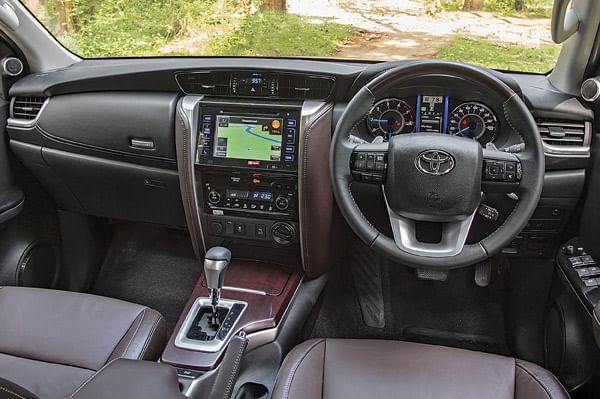
The Endeavour keeps it simple. The dashboard isn’t as lavishly laid out as the Toyota’s but it’s clean and functional, with fewer buttons to get lost in. There are a few low-quality plastic bits here too, like the flimsy feeling gear lever, but they’re less obvious. This dash has a nice brown leather top, while the rest is finished in beige. The Ford’s steering wheel is also draped in buttons, but what I really like is the instrument panel, which is made up of an analogue speedometer, flanked by two colour screens that display everything from a tachometer, to off-road settings, to media and fuel information. It’s really high tech.
And speaking of tech, both cars are pretty well loaded up. Both have touchscreen infotainment systems, and while the Fortuner’s is functional, it feels a little old-school and sometimes a little hesitant to respond. The Ford’s screen, in contrast, feels bang up to date, with smooth performance, a high resolution and an intuitive layout. Both cars get a wide range of features in their top-spec forms, including satellite navigation, rear parking sensors, powered tailgates (with memory function), eight-way power-adjusted driver’s seats, leather upholstery, hill ascent and descent control, seven airbags, ABS with EBD, traction control, stability control, cruise control, a rear-view camera, dual-zone climate control, rear air-con and automatic headlamps. The Fortuner does get ahead with a few unique features – keyless entry and go, paddle shifters and telescopic steering adjustment; the Endeavour doesn’t get those. The list of things the Ford does have that the Toyota does not, however, is much longer – separate rear AC temperature control, front parking sensors, auto-parking assist, emergency assist, active noise cancellation, automatic wipers, headlamp washers, electrochromatic rear-view mirror, electric-folding third row seats, tyre pressure monitor, heated wing mirrors, and most significantly, a panoramic sunroof. Indians love their sunroofs, and because the Fortuner’s rear AC ducting is in the roof, a sunroof was just not possible.
FLIP ’N‘ SLIDE
The seats in premium family SUVs like these are arguably as much about flexibility and practicality as they are space and comfort, in case their owners someday put them to their fullest use. Going back to front, then, the third rows of both these cars split and flip to expand the luggage bay, but in different ways. The Ford’s trick one-touch power-folding seats are handy when your hands are full, whereas the Toyota’s seats have to be lifted and clamped to the side to free up the most space. Both cars can take a big suitcase with the third row up, but the Endeavour has the slightly lower loading lip. However, the Fortuner’s seats themselves are better, offering softer cushioning, a nicer seating position, and the ability to recline the backrest.
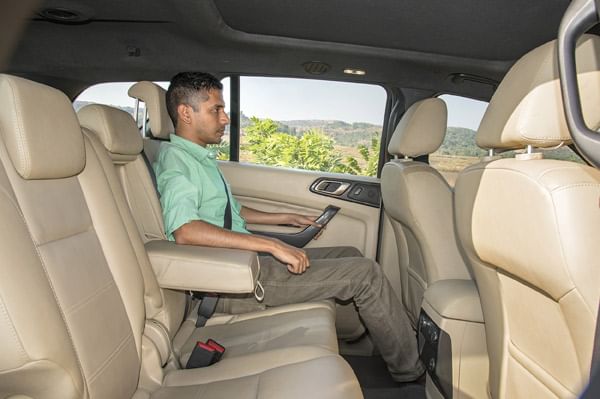
It’s a similar story in the middle row. The Endeavour’s seat is comfy enough and offers good support, but its cushions are just that little bit firmer than the Fortuner’s. The Toyota’s seats feel much plusher and offer better thigh support. Both middle rows have a backrest recline function, and both can be slid back and forth for variable legroom, but even though the Endeavour might have a slight edge here, it’s not enough to fault the Fortuner on. What we will fault the Fortuner on is access to the cabin, because it’s quite a hike getting in, and you have to use the handhold that’s notched into the B-pillar to haul yourself in; it’s much less effort climbing into the Endeavour. But yet again, the Toyota scores another point by letting you fold and flip the middle row forward with just one quick lever pull that gives you much wider access to the last row. The Endeavour’s middle row will only flip down and slide forward a bit.
BULL BY THE HORNS
I’ve left telling you about the front seats for this section, because they’re a crucial part of the driving experience. Both are comfy, but again, the Fortuner just edges ahead with softer cushions and slightly better lateral and thigh support. However, while both powered driver’s seats offer a wide range of adjustment, the Fortuner’s seating position still feels a bit too utilitarian. What doesn’t help is the tall, bolt-upright dashboard, and no matter how high or low you have the seat set, the immense ride height means you always feel like your sat ‘on’ the car rather than ‘in’ it, which is a bit disconcerting on the move. The Endeavour just feels a whole lot friendlier from behind the wheel. Visibility is much better thanks to the lower dashboard, and you have a lower, more car-like centre of gravity, making it much easier to get comfortable with the SUV. It may not seem like much, but it makes a world of a difference when you have to negotiate something so big through traffic.
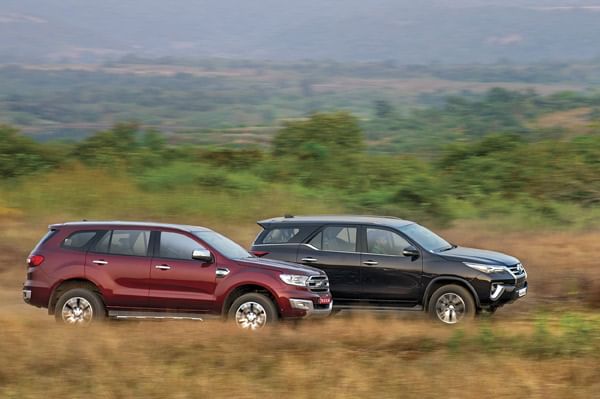
Then there’s the steering itself – yes, the Fortuner gets you the added benefit of telescopic adjustment, but it’s the Endeavour’s electric power steering that really gives it an advantage. It’s so light and easy to use at any speeds, making this 2.4-tonne SUV feel as easy to steer as an EcoSport. The best part is that it weighs up well as you go faster, instilling confidence at higher speeds, and though there is some slack, it’s still pretty direct for a car of this size. Just goes to show, Ford always gets steering right, even in a massive off-roader like this.
Toyota has stuck with an old-school hydraulic power steering setup for the new Fortuner, and like much else in this car, it’s a huge improvement from the old one. However, it still feels far too heavy at parking and traffic speeds, and that only amplifies this car’s size. There is a slight advantage in that it feels a bit more secure at highway speeds than the Ford, but the disadvantages, like the sharp shock or kickback when you hit a bump, outweigh it. The highway, as ever, is where the Fortuner excels, and its slightly stiffer setup means it rides extremely flat at three-digit speeds. It also means body roll is better contained than you expect from such an elephantine car riding high off the ground.
The ride at very low speeds is also good, with a nice soft edge to it. Up the pace even slightly, though, and the firm setup ensures you feel a lot of movement in the cabin. Every little road imperfection will rock you around.
The Endeavour is not perfect either, erring too far instead on the soft side. This means that you get more body roll through corners and a lot of float and pitching over undulations at higher speeds. At low speeds, it does feel a little lumpy, but overall, bump absorption is a bit better than the Fortuner, especially as you pick up speed. It makes a better compromise than the Toyota, keeping you more comfortable over more surfaces, so it has the better ride, all things considered. And sure, it rolls through corners, but it’s the nicer steering, lower centre of gravity and friendlier driving position that make you want to drive the Ford harder than the Toyota. But then, if it’s driving dynamics you value most in your seven-seat SUV, you’re better off with a monocoque-based one like a Hyundai Santa Fe.
STAMPEDE
Both these cars use industrial-grade diesel engines borrowed from pick-up trucks designed to haul heavy loads, so don’t expect much in the way of refinement or finesse. They’re both quite noisy once you rev them up, with the Fortuner making a loud boom versus the Endeavour’s mechanical clatter, and that’s only to be expected from such cars. They do have the numbers though – the Fortuner’s brand new 2.8-litre, four-cylinder motor makes 177hp and 450Nm of torque, while the Endeavour’s 3.2-litre, five-cylinder engine punches out 200hp and 470Nm! The Ford gets to 100kph a second quicker than the Toyota, but then what’s more relevant is how these two motors make their power.
The Endeavour’s motor is much more relaxed in comparison. There’s more lag to get through at the bottom end, but it is more eager to rev out, letting you access a much wider powerband once you do. So it does have the punch, but you just have to go a little further to access it, which can actually be a bit more enjoyable. The six-speed auto in this car, however, isn’t as quick to react or to shift as the Toyota’s, and you’ll sometimes catch it fumbling when you want to make a quick overtake.
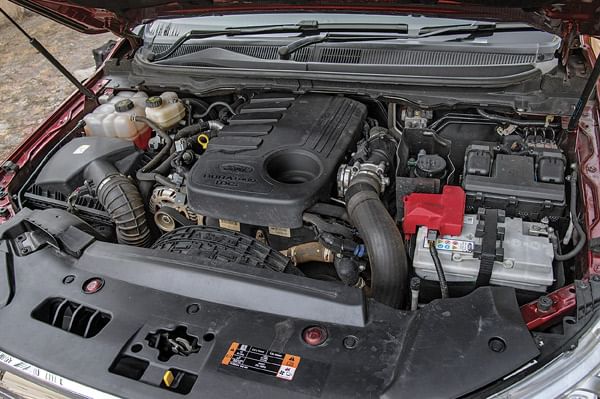
And, even though they’ll rarely be used this way, since we did push them to their limits, it’s worth talking about what these 4x4s are like off-road. The new Fortuner has moved from full-time 4WD to selectable 4WD, so you can use it in 2WD to save fuel most of the time. It’s also got a 4WD Low Range mode in case you want to do some serious rock crawling. The Endeavour does have a low-range mode too and it lets you lock the rear diff, but it doesn’t let you disengage the front driveshafts manually. What it has instead is Terrain Management, an electronic traction control system that adjusts all the car’s parameters for you depending on the mode you choose – Road, Sand, Snow/Mud and Rock. In practice, both SUVs are incredibly capable off-road. Both have incredibly high approach and departure angles, meaning they can ascend and descend really steep slopes with ease. However, though the Endeavour has the higher ground clearance (225mm) on paper, its longer wheelbase means its breakover angle is smaller, meaning it’s not as good at crossing tall obstacles as the Fortuner. All things considered, it’s the Toyota, with its stronger low-end grunt and manually controlled 4x4 that’s the more effortless in the rough stuff; the Endeavour gets the job done too, but as it’s more reliant on electronics, it can struggle on seriously difficult obstacles.
HIGH & MIGHTY
As we’ve said several times in this test, the Fortuner is so much better than its predecessor, and that is no small feat. Not only has it improved on every mechanical front – engine, gearbox, ride and handling – but the interior is far more upmarket and the shock-and-awe exterior just wipes the old car’s rather plain look from memory. Plus, the other thing that customers love about Toyota will always remain – its rock-solid reliability. But we’re not comparing it to the old Fortuner, we’re comparing it to the Endeavour.
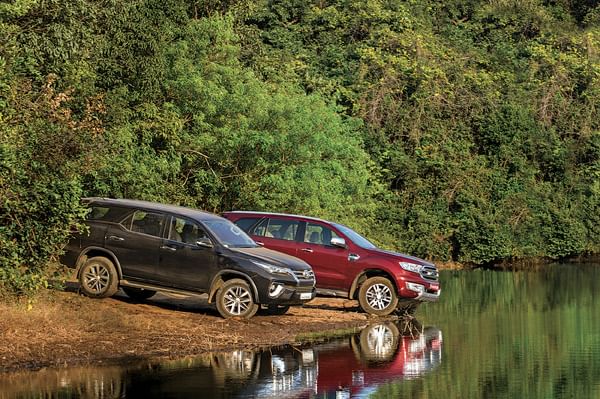
The Ford is arguably not as visually arresting as the Toyota, it’s not quite as good off-road and its powertrain is a bit more lethargic overall. The seats too aren’t as comfortable, which is important as these cars are often chauffeur driven in India. In just about every other facet, though, the Endeavour comes out on top, if not on par. It rides better, it has the nicer cabin, it’s much easier and more fun to drive and it’s much better equipped. Cap it off with a price that’s just a smidge lower, and you can see where we’re going here. We have no doubt the Fortuner, with its diehard fan following, will find a lot of new owners, and this comparison test has really come down to the wire. But ultimately, it’s the Endeavour that is the better SUV of the two.
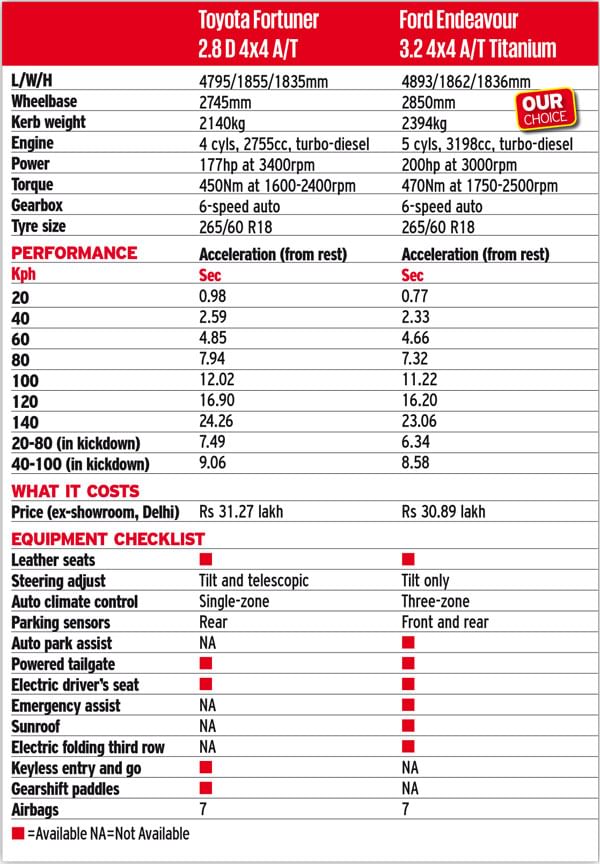







Comments
Member Login
Personal Details
No comments yet. Be the first to comment.